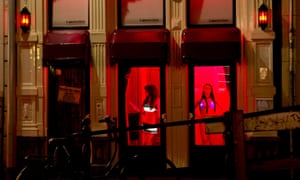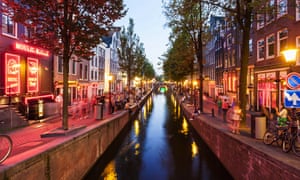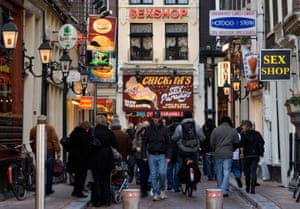AMSTERDAM MAYOR OPENS NEW MODEL BROTHEL RUN BY PROSTITUTES

A brothel in the red light district of Amsterdam.
In a bid to improve working conditions in the city’s sex industry, a brothel run by prostitutes themselves will be opened today by the mayor of Amsterdam.
An initiative of the city council, the new brothel occupies 14 “windows” across four buildings on the so-called Wallen, Amsterdam’s red light district. About 40 sex workers will be able to operate out of the premises, which are being run by a foundation called My Red Light, in which prostitutes take an active part.
“Everything in this project, from the statutes to the decoration of the rooms, is thought out by sex workers,” said one of the prostitutes involved, who asked to remain anonymous. “It is my hope that My Red Light will offer pleasant workspaces, where sex workers can be who they are and feel welcome.”
Prostitution has been legal in the Netherlands since 2000. Owners of sex businesses must obtain a licence and adhere to municipal rules, while prostitution is a legal profession and its practitioners are expected to pay taxes.
The Dutch hoped that by legalising prostitution they would create a “clean” sex industry, where independent sex workers could earn money unhindered by pimps.
It didn’t work out that way. Amsterdam has continued to be an important destination for human traffickers, often via criminal gangs from eastern Europe.

The Wallen, Amsterdam’s highest profile red light district.
In an effort to combat organised crime in the red light district, Amsterdam started closing windows on the Wallen in 2007. This policy had negative side effects for prostitutes, however. Due to their scarcity, the rent for windows went up. Some landlords saw a chance to force women to pay for their window even when they were not working, for example during holidays or periods of illness.
With this new initiative, Amsterdam hopes to enable prostitutes to work independently.
“Sex workers will determine their own rental terms and working hours,” says Marieke de Ridder, member of the supervisory board of My Red Light. “There will also be more social control, because the sex workers in My Red Light will be more involved with each other. There’s a special living room where they can drink tea and socialise with each other – clients are not allowed there. We hope they will educate each other when it comes to things like negotiating or dealing with unpleasant customers.”
The mayor of Amsterdam, Eberhard van der Laan, went to great lengths to make it all happen. Because of his involvement, the Dutch have dubbed the project the “municipal brothel”.
But the manager of the city’s prostitution programme, Sonja Pol, is quick to emphasise this is not the case. “The mayor has done everything within his powers to help to start up the project: a feasibility study, risk assessment, getting the right parties around the table, finding investors and financiers. But we now don’t play any role in the project any more – just monitoring it for the next two years.”
She adds: “The initiative is interesting for Amsterdam because it can contribute to the emancipation and self-employment of sex workers in Amsterdam. When sex workers have a say in where, how and when they are working, they become less dependent on third parties. By setting up their own window brothel, sex workers acquire knowledge, experience and a position to develop themselves.”
A male prostitute involved in setting up My Red Light agreed. “Thanks to My Red Light, I have experienced enormous personal and professional growth,” he said. “All sex workers working together on a shared, emancipatory goal. That’s something very special.”

Amsterdam’s red light district in 2008. Many ‘windows’ have since been closed down in an effort to cleanse the area of organised crime.
The new brothel is housed in four buildings that Amsterdam bought in 2007 from the infamous brothel-owner “Fat” Charles Geerts, also known as the King of the Wallen, in an effort to make him leave the red light district. The buildings have now been sold to a social investment fund, which rents them out to My Red Light.
The Dutch bank Rabobank has granted My Red Light a start-up loan, and the health care institution HVO-Querido is providing guidance for the prostitutes, most of whom have little to no experience of setting up a business.
The rooms are bigger and more colourful than is usual in the Amsterdam red light district. The plan is to also organise trainings and courses for the prostitutes. “We are thinking about courses in massage, but also in accounting and the fiscal aspects of the work,” said De Ridder.
“We are very excited about this experiment,” she added. “Because if it works out, we have a whole new model for prostitution. We are also anxious to see how neighbourhood residents and window landlords are going to react in the long run. Will they embrace it or turn against it?”
Not everybody in the Netherlands is enthusiastic about the new brothel. Prostitution researcher Karin Werkman thinks the whole project is questionable. “One simply cannot know whether a woman renting a window there does or does not give up her earnings to a pimp,” she said. “Prostitution is a form of sexual exploitation, and even in a controlled environment there can be no guarantees of ‘clean’ prostitution. The only people who benefit from this are the sex buyers. They can tell themselves that by going to this place they are making use of ‘clean’ prostitution. But that really is an illusion.”
She also thinks the council’s involvement in starting up the project is problematic. “The council is at their wit’s end when it comes to all the problems and criminality in the red light district. So now they trying to do something extremely innovative. It’s really in the council’s interest that this whole thing works out well. So I wonder, if something does go wrong, if it turns out there are pimps involved, will we be properly informed?”
“There are no guarantees that in a business run by sex workers themselves nothing will ever go wrong,” adds Pol. “And the council realises full well that My Red Light is not the solution for the problems in the sex industry. That’s not what this project is meant for. What we are aiming at is empowerment for sex workers.”

Comments
Post a Comment